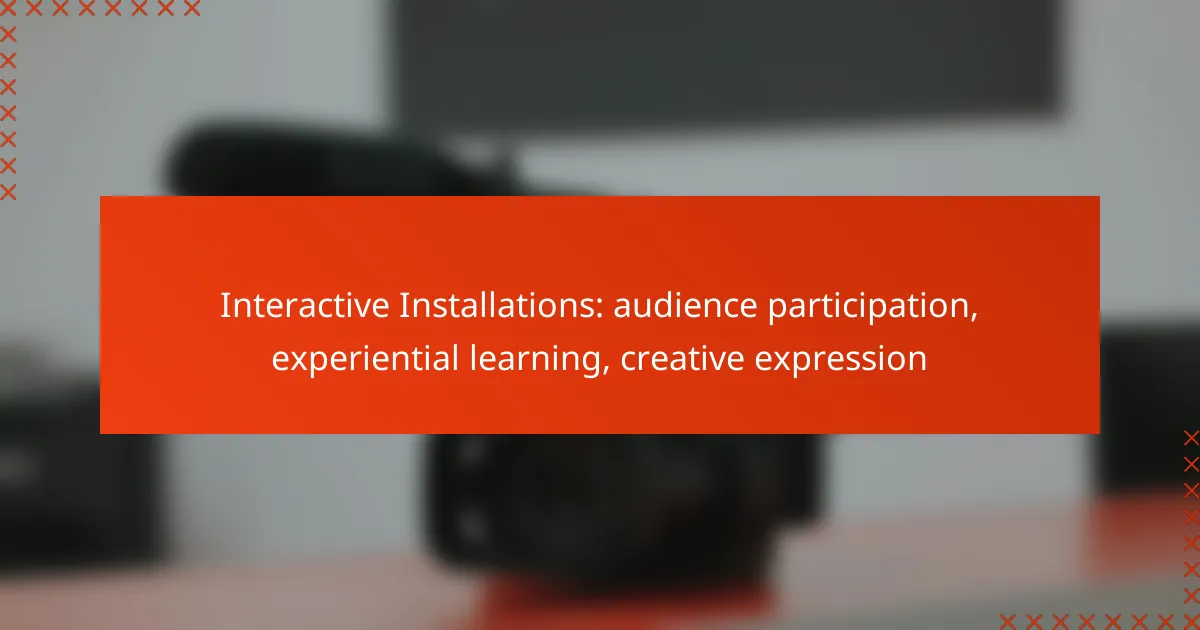Virtual reality (VR) revolutionizes the film experience by immersing viewers in interactive storytelling that transcends traditional narratives. By leveraging innovative technology, VR films engage audiences in unique ways, allowing them to feel like active participants within the story. This transformative approach not only enhances viewer participation but also creates a deeper emotional connection to the narrative.
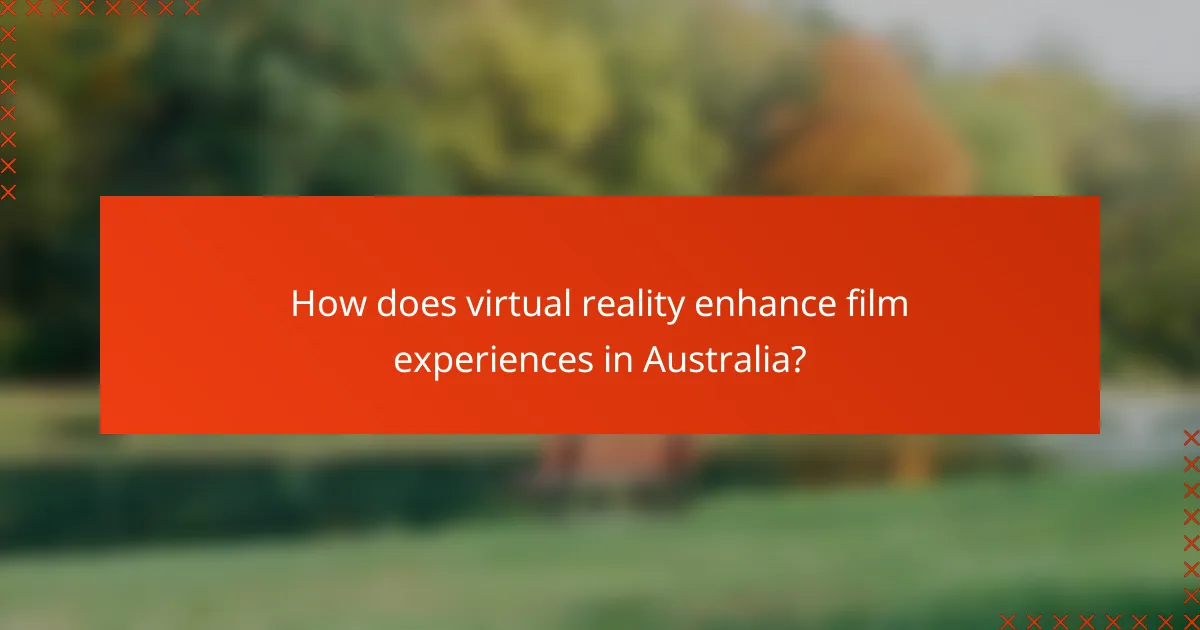
How does virtual reality enhance film experiences in Australia?
Virtual reality (VR) significantly enhances film experiences in Australia by creating immersive environments that allow viewers to engage with stories in unprecedented ways. This technology transforms traditional storytelling into interactive experiences, enabling audiences to feel as though they are part of the narrative.
Immersive storytelling techniques
Immersive storytelling in VR films involves crafting narratives that allow viewers to explore environments and interact with characters. This technique often includes non-linear storylines, where choices can lead to different outcomes, enhancing emotional investment. For example, Australian VR films may utilize local landscapes and cultural elements to deepen the connection with the audience.
Producers should focus on creating rich, detailed worlds that encourage exploration. This can involve using 360-degree video and spatial audio to make the experience more engaging and realistic. The goal is to make viewers feel as if they are stepping into the story rather than just watching it unfold.
Innovative technology integration
Innovative technology integration in VR films includes the use of advanced graphics, motion tracking, and haptic feedback to enhance realism. Australian filmmakers are increasingly adopting these technologies to create visually stunning experiences that captivate audiences. For instance, VR headsets equipped with motion sensors allow viewers to look around and interact with the environment seamlessly.
It’s essential for filmmakers to stay updated with the latest VR technologies and tools. Collaborating with tech companies can provide access to cutting-edge resources that improve production quality. Additionally, understanding the hardware capabilities of popular VR platforms can help tailor experiences for different audiences.
Audience engagement strategies
Effective audience engagement strategies in VR films focus on creating participatory experiences that resonate with viewers. This can include interactive elements that allow audiences to influence the storyline or character decisions, fostering a sense of agency. Australian filmmakers can leverage local themes and narratives to enhance relatability and connection with the audience.
To maximize engagement, filmmakers should consider hosting live VR events or screenings where audiences can experience the film together. This communal aspect can enhance the emotional impact and create a shared experience. Additionally, utilizing social media platforms to promote these events can help attract a wider audience and generate buzz around the film.

What are the best virtual reality films currently available?
The best virtual reality films combine immersive storytelling with innovative technology to engage audiences in unique ways. Currently, titles that stand out offer rich narratives, stunning visuals, and interactive elements that enhance viewer participation.
Top VR films of 2023
In 2023, several virtual reality films have gained attention for their groundbreaking approaches. Notable examples include “The Hangman at Home,” which blends horror with interactive storytelling, and “Gondwana,” an environmental narrative that immerses viewers in lush, animated landscapes.
These films often utilize advanced VR technology to create a sense of presence, making viewers feel as if they are part of the story. Engaging with the content can vary from passive viewing to active participation, depending on the film’s design.
Notable Australian VR filmmakers
Australia is home to several prominent VR filmmakers who are pushing the boundaries of the medium. Directors like Lynette Wallworth and David Wenham have created impactful works that explore themes of identity and environment through immersive experiences.
These filmmakers often collaborate with local artists and technologists to enhance storytelling and audience engagement. Their projects frequently receive recognition at international film festivals, showcasing the potential of Australian talent in the VR landscape.

How does audience engagement work in virtual reality films?
Audience engagement in virtual reality (VR) films occurs through immersive experiences that allow viewers to interact with the narrative and environment. This engagement is enhanced by innovative technology that creates a sense of presence, making the audience feel like active participants in the story.
Interactive storytelling elements
Interactive storytelling elements in VR films enable viewers to influence the plot and character decisions. This can include branching narratives where choices lead to different outcomes, allowing for a personalized experience. For example, a viewer might choose to follow one character’s journey over another, leading to unique story arcs.
Additionally, VR films often incorporate environmental interactions, where viewers can manipulate objects or explore settings in a way that affects the narrative flow. This level of interactivity enhances emotional investment and keeps the audience engaged throughout the experience.
Feedback mechanisms for viewers
Feedback mechanisms in VR films are crucial for enhancing audience engagement by providing real-time responses to viewer actions. Haptic feedback, for instance, can simulate physical sensations, making interactions feel more realistic and impactful. This technology can create a stronger connection between the viewer and the story.
Moreover, visual and auditory cues can guide viewers, indicating when they have made significant choices or reached important plot points. These feedback systems help maintain immersion and encourage viewers to explore different narrative paths, ultimately enriching their overall experience.
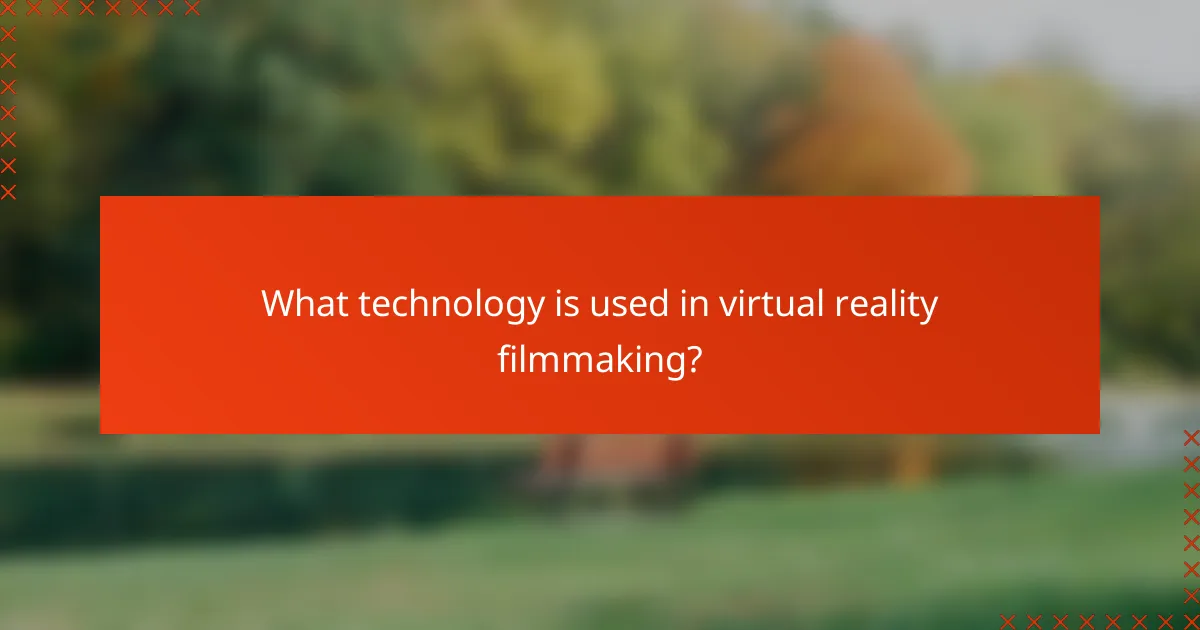
What technology is used in virtual reality filmmaking?
Virtual reality filmmaking utilizes a combination of advanced hardware and software to create immersive experiences. Key technologies include VR headsets, 360-degree cameras, and specialized editing software that enables storytelling in a three-dimensional space.
VR headsets and equipment
VR headsets are essential for experiencing virtual reality films, as they provide the necessary visual and auditory immersion. Popular models include the Oculus Quest, HTC Vive, and PlayStation VR, each offering varying levels of resolution and comfort.
In addition to headsets, filmmakers often use 360-degree cameras like the Insta360 One X2 or the GoPro MAX to capture footage. These cameras allow for a full panoramic view, enabling viewers to look around in all directions while watching the film.
Software for VR film production
Software plays a crucial role in VR filmmaking, with tools designed for editing and post-production specifically tailored for immersive content. Programs like Adobe Premiere Pro and Final Cut Pro now offer features for 360-degree video editing, allowing filmmakers to seamlessly stitch together footage.
Additionally, platforms such as Unity and Unreal Engine are popular for creating interactive VR experiences. These engines provide robust environments for integrating graphics, sound, and user interactions, enhancing audience engagement in storytelling.

What are the benefits of virtual reality in storytelling?
Virtual reality (VR) enhances storytelling by immersing audiences in a three-dimensional environment, allowing for deeper engagement and emotional resonance. This innovative technology transforms traditional narratives into interactive experiences, enabling viewers to feel as if they are part of the story.
Enhanced emotional connection
VR fosters a stronger emotional connection by placing viewers directly in the narrative. When users can explore a story from within, they often experience heightened empathy towards characters and situations, making the story more impactful.
For example, a VR film that allows users to walk alongside a character during a pivotal moment can evoke feelings of joy, sorrow, or tension more effectively than conventional media. This immersive quality can lead to lasting impressions and discussions long after the experience ends.
Unique viewer perspectives
Virtual reality offers unique perspectives that traditional storytelling cannot match. Viewers can choose their vantage points, allowing them to see events unfold from different angles and even influence the narrative flow. This interactivity can create a more personalized experience.
For instance, in a VR documentary, a viewer might explore a historical event from the perspective of various participants, gaining insights into their motivations and emotions. This multifaceted approach can enhance understanding and retention of the story being told.
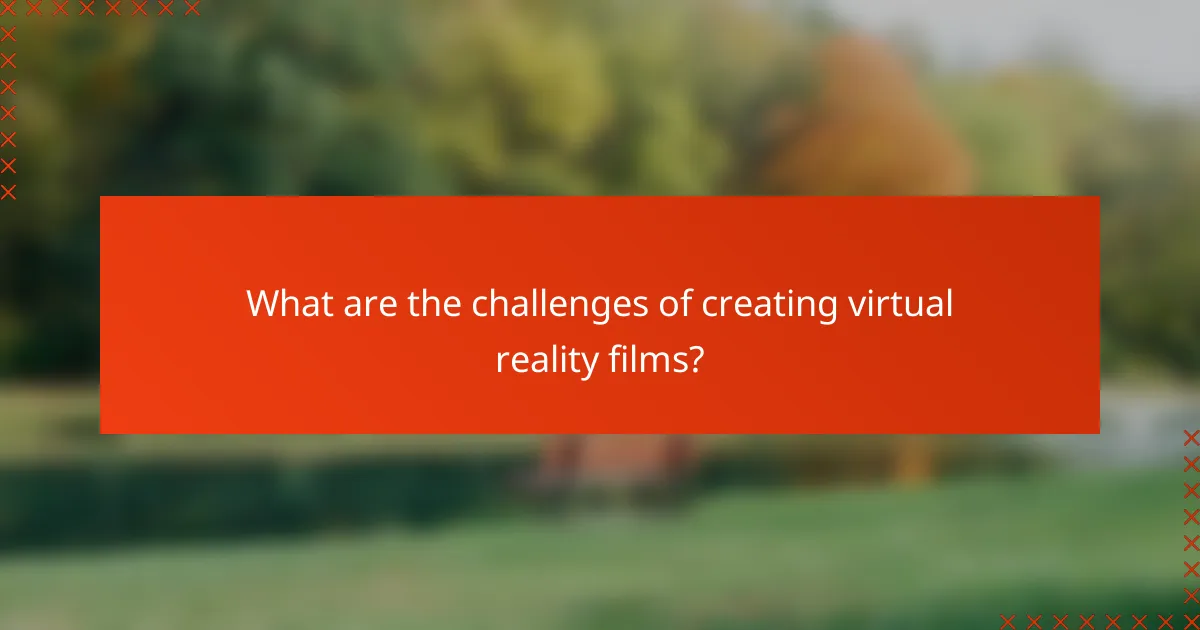
What are the challenges of creating virtual reality films?
Creating virtual reality films involves several challenges, including technical limitations and audience accessibility issues. These factors can significantly impact the production process and the viewer’s experience.
Technical limitations
Technical limitations in virtual reality filmmaking often stem from hardware and software constraints. For instance, high-quality VR experiences require powerful graphics processing units (GPUs) and advanced rendering techniques, which can be costly and complex to implement.
Additionally, the need for real-time rendering can lead to trade-offs in visual fidelity. Filmmakers must balance detail and performance to ensure a smooth experience, often resulting in lower resolutions or simplified graphics in certain scenes.
Audience accessibility issues
Audience accessibility issues can hinder the widespread adoption of virtual reality films. Many potential viewers may not have access to the necessary VR headsets or compatible devices, limiting the audience size. Furthermore, the cost of high-quality VR equipment can be a barrier for many consumers.
Moreover, users may experience discomfort or motion sickness when using VR, which can deter them from engaging with this medium. Filmmakers should consider designing experiences that minimize these effects, such as reducing rapid movements and providing adjustable settings for comfort.
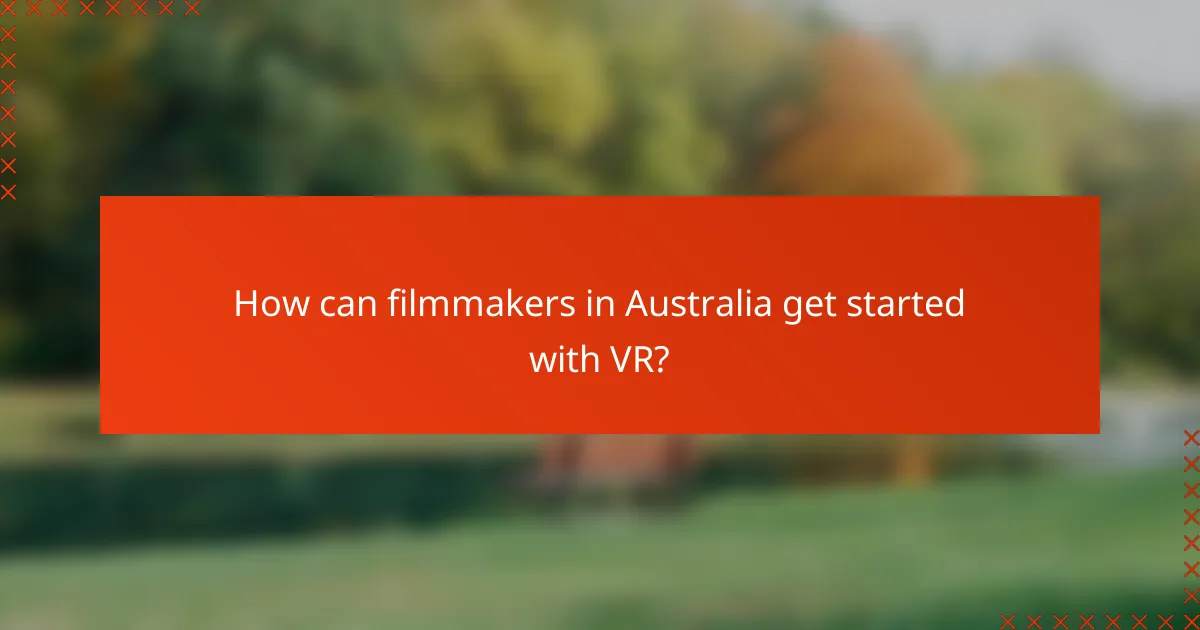
How can filmmakers in Australia get started with VR?
Filmmakers in Australia can begin their journey into virtual reality (VR) by understanding the technology and tools available, as well as the unique storytelling opportunities it presents. Engaging with local resources and communities can facilitate a smoother entry into this innovative medium.
Essential tools and resources
To create VR films, filmmakers need specific tools such as 360-degree cameras, VR editing software, and audio equipment designed for immersive sound. Popular cameras include the Insta360 One X2 and the GoPro MAX, while software options like Adobe Premiere Pro and Unity are widely used for editing and developing VR content.
Additionally, online platforms like YouTube and Vimeo offer VR content hosting, allowing filmmakers to showcase their work. Local Australian organizations, such as the Australian Film Television and Radio School (AFTRS), provide valuable resources and support for emerging VR creators.
Training programs and workshops
Participating in training programs and workshops can significantly enhance a filmmaker’s VR skills. Institutions like AFTRS and Screen Australia often host workshops focused on VR storytelling, production techniques, and post-production processes. These programs typically cover both the technical aspects and creative storytelling approaches unique to VR.
Filmmakers should also consider online courses from platforms such as Coursera or Udemy, which offer flexible learning options on VR filmmaking. Engaging with local VR communities through meetups or conferences can provide networking opportunities and insights into industry trends.



